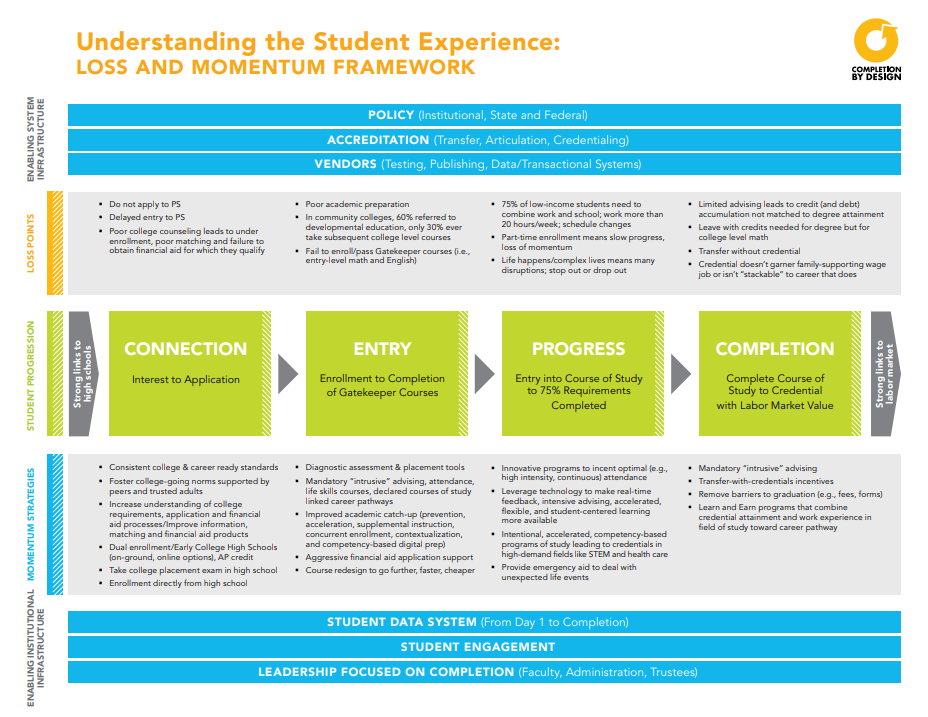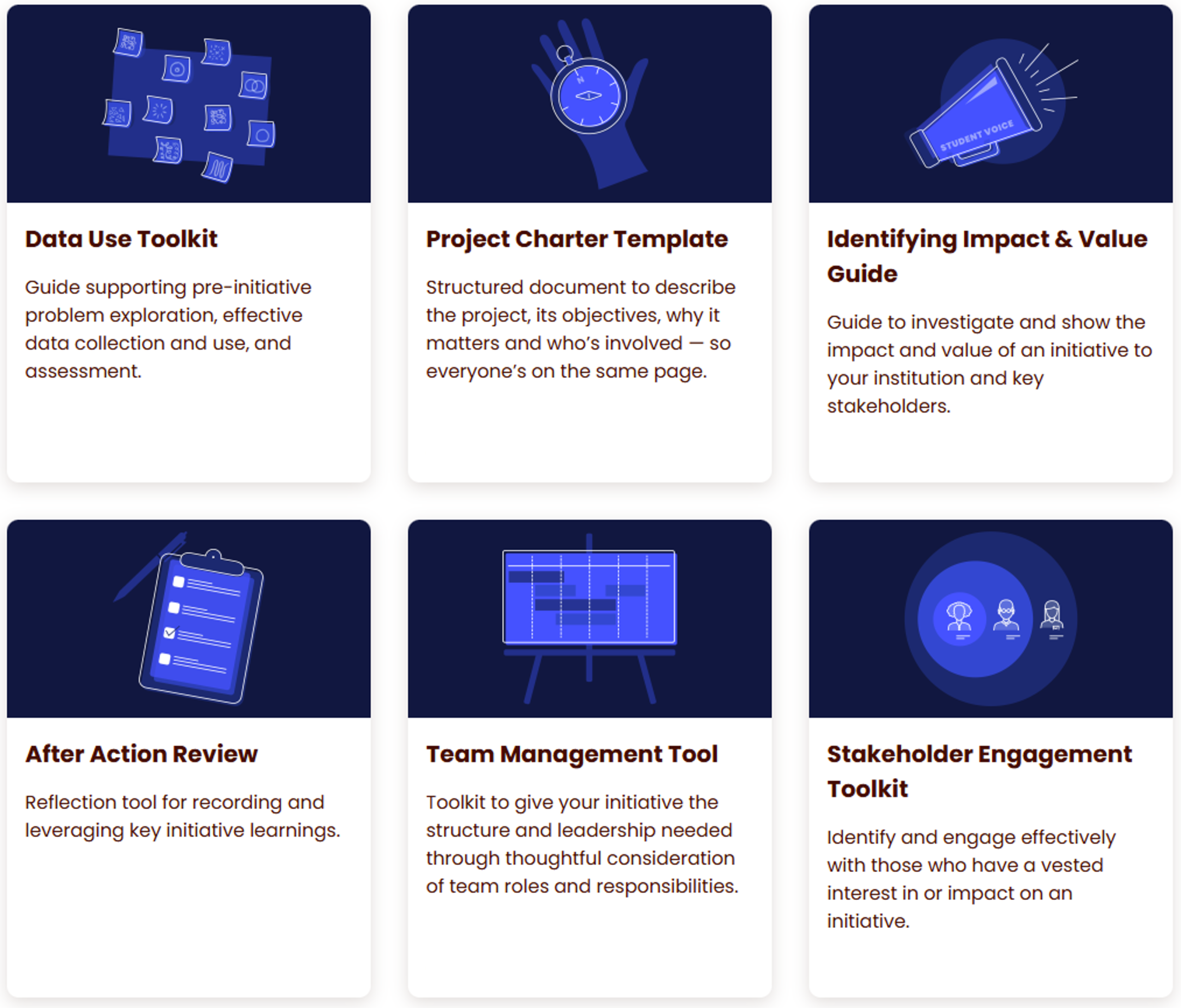Take Action: Spotlighting Impact
Ready to get to work?
There’s no shortage of transformation resources out there developed by institutions, researchers, and organizations leading the way on equitable student success. But with so many available, it can be difficult to know where to begin or which tools are truly built for action.
This page spotlights a small set of high-impact resources that do more than inform. These frameworks and tools are designed to help you roll up your sleeves and take the next step. Each one is practical, proven, and aligned with how transformation actually happens on the ground
Use them to organize your efforts, engage your teams, and move your transformation work forward.
Take Action: Spotlighting Impact
Ready to get to work?
There’s no shortage of transformation resources out there developed by institutions, researchers, and organizations leading the way on equitable student success. But with so many available, it can be difficult to know where to begin or which tools are truly built for action.
This page spotlights a small set of high-impact resources that do more than inform. These frameworks and tools are designed to help you roll up your sleeves and take the next step. Each one is practical, proven, and aligned with how transformation actually happens on the ground
Use them to organize your efforts, engage your teams, and move your transformation work forward.

Spotlighting Resources
Leading examples of action-oriented resources for institutions transforming for student success.
I want a...
…macro-level approach to transformation that positions the experiences of students at the center and structures change efforts around it.

The Loss/Momentum Framework
The Loss/Momentum Framework (LMF) is one of several frameworks that lay out an approach to institutional transformation at a high level. Specifically, the LMF prioritizes better understanding the student experience and using that understanding to identify specific areas within the institution for reform and redesign.
Like most frameworks, the LMF connects to many principles of how institutions transform and is relevant across many stages of the transformation journey.
- It is particularly useful in the early stages of the transformation journey, for institutions seeking to Lay the Groundwork, Start the Process, or Sharpen the Focus.
- The LMF’s Momentum Strategies highlight many Evidence-Based Practices (including advising and developmental education reform) and organizes them according to when they appear along the student experience.
- It bolsters the Student-Centered Mission capacity by clearly prioritizing the experiences of students at the center of transformation efforts.
- It strengthens the Catalytic Leadership capacity by offering senior leaders an approach to organizing transformation efforts at the highest level and providing mid-level leaders with a helpful structure for organizing and working within cross-functional teams.
Learn more about the value of centering the student experience, as well as step-by-step guidance for using the LMF to structure change efforts in this LMF inquiry guide.
View the original LMF one-pager for a concise, visual breakdown of the framework.
View an updated LMF one-pager created by Achieving the Dream that expands the framework to include a fifth stage, Transition, that covers the student experience of transitioning into the workforce or to another institution.
I want a...
…set of practical tools for mid-level leaders to get transformation projects started, share their findings, and manage everything in-between.

The Mid-Level Leader Toolkit
The Mid-Level Leader (MLL) Toolkit is a suite of six tools collaboratively designed by a group comprised of mid-level leaders at institutions and higher education researchers. It’s grounded in the notion that long-term transformation efforts are made real by implementing specific projects or initiatives, and the success of those projects is heavily dependent upon the ability of mid-level leaders to provide support in a handful of critical ways that shift over the life of the project.
The tools in the MLL Toolkit represent the most critical functions that MLLs have carried out in previous institutional transformation initiatives. They are designed to help MLLs perform these roles more efficiently and sustainably, while maintaining high quality. Many of these functions are closely aligned with Continuous Improvement Processes, which provide the structure and process discipline needed to implement with fidelity and embed effective practices over time.
The tools, and examples of their most relevant connections to the principles of how institutions transform, are…
- Data Use Toolkit – Tied to the Strategic Data Use capacity, this tool supports target-setting and performance tracking.
- Project Charter Template – This tool provides critical structure for planning, ideal for teams in the Sharpen the Focus stage.
- Team Management Tool – This tool supports the Catalytic Leadership capacity by helping leaders build and manage strong cross-functional teams.
- Stakeholder Engagement Toolkit – This tool strengthens Catalytic Leadership capacity by providing strategies for inclusive engagement.
- After Action Review – This tool bolsters institutions’ Strategic Data Use capacity by supporting reflection and building lessons into efforts going forward.
- Identifying Impact & Value Guide – This tool engages Catalytic Leadership capacities by supporting leaders in communicating the impact and value of a project after implementation.
Explore the Mid-Level Leader Toolkit in more detail.
I want a...
…polished, research-backed platform for organizing and using our student data across all five stages of the transformation journey.

The Postsecondary Data Partnership
The Postsecondary Data Partnership (PDP) is an ongoing, nationwide student data platform focused on student outcomes. Unlike limited datasets from sources like IPEDS or one-off grant reports, the PDP offers institutions a more holistic and actionable way to measure, monitor, and improve student success. For institutions with lean or growing institutional research and data teams, participating in the PDP can transform the way you measure and report students’ progress toward a credential – it tracks all new students (not just full-time, first-time fall entrants), integrates the latest learning about early momentum indicators of student success, and provides benchmarking tools to compare performance across peer institutions.
The PDP is well-positioned to support institutions’ Strategic Data Use capacity. What makes it such a standout resource is how broadly it supports that core capacity across all five stages of the transformation journey:
- Lay the Groundwork – The PDP can provide a foundation of student data critical for communicating the urgent need for institutional transformation and supporting on-the-ground transformation efforts that follow.
- Start the Process – The early momentum metrics available through the PDP can help establish a shared baseline that centers the student experience and is representative of the entire institution.
- Sharpen the Focus – Teams of experts can review disaggregated student data to explore opportunities for dramatically impacting the student experience and use those data to set detailed targets for transformation initiatives.
- Act with Purpose – The metrics defined by the PDP simplifies the process of developing implementation plans by providing shared definitions and supporting teams in identifying meso- and micro-level metrics to track in support of macro-level targets.
- Sustain and Evolve – The PDP’s dashboards provide clear reference points for monitoring progress against targets and iterating practices to increase outcomes.
Explore the Postsecondary Data Partnership (PDP) in more detail.
See all Tools and Frameworks
Discover how institutions like yours have navigated their transformation journeys. Browse real-world case studies and gain insights you can apply today.


